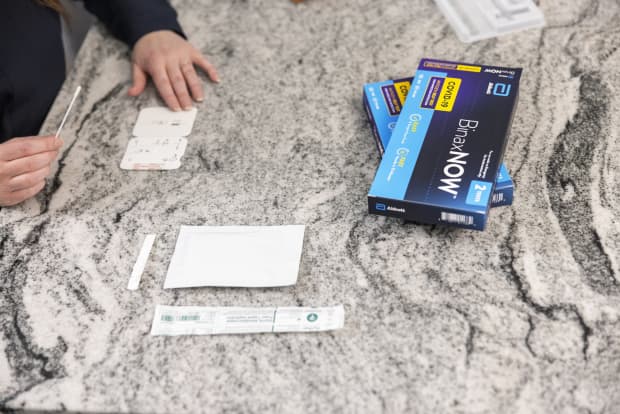This post was originally published on this site
Getting a COVID test is going to feel a lot like buying Tylenol in the coming weeks — no appointment or prescription necessary.
The Food and Drug Administration recently granted emergency use authorization for two types of rapid-result over-the-counter COVID-19 tests.
However, these over-the-counter test results are not as accurate as polymerase chain reaction tests (PCR), which require a lab to process.
Consumers must pay for two tests per packet. The companies say this is to help provide more accurate results, and advise testing again after 36 hours.
The FDA has granted emergency use authorization for people to self-swab if they are 14 or 15 years or older, depending on which test is used. It takes 10 to 15 minutes for the test results to appear.
“
‘Negative results should be treated as presumptive.’
”
And now a warning: “Negative results should be treated as presumptive,” the FDA said in its letters of authorization for Abbott and Quidel’s at-home tests.
“Do not rule out SARS-CoV-2 infection,” it said, adding that such over-the-counter tests should not be used as the sole basis for treatment or patient management.
“Individuals who test negative and continue to experience COVID-19 like symptoms of fever, cough and/or shortness of breath may still have SARS-CoV-2 infection and should seek follow up care with their physician or healthcare provider,” the FDA said.
What will they cost?
Currently, the only two at home tests that don’t require a prescription or a telehealth provider to supervise are Quidel’s
QDEL,
QuickVue test and Abbott’s BinaxNOW COVID-19 Antigen Self Test
ABT,
A Quidel spokeswoman told MarketWatch that the company is “looking to bring these tests to market by end of April at a price point of less than $30 for a two-test kit configuration (less than $15/test).”
The company hasn’t announced where the tests will be sold.
“
The over-the-counter tests, which will include supplies to perform two tests, will likely cost between $10 and $15 per test.
”
Abbott’s BinaxNOW Self Test “will be available nationwide and in large quantities at major food, drug and mass merchandiser retailers nationally and will be priced affordably, similar to common over-the-counter (OTC) tests,” a March 31 statement published by Abbott states.
“The test will come in a two-count box to meet serial (frequent) testing requirements,” the company said in a statement.
An Abbott spokesperson told ABC News that “the tests are expected to be sold in packs of two and will cost under $10 dollars per test.”
Abbott did not respond directly to MarketWatch inquiry regarding a price point for the tests and when consumers could expect to purchase them.
“With ongoing demand for testing, we continue to evaluate newly approved products that could provide our customers with additional convenient and affordable options,” Matt Blanchette, a CVS
CVS,
spokesperson told MarketWatch.
Walgreens
WBA,
did not respond to MarketWatch’s request for comment.

A step-by-step guide included in Quidel’s QuickVue test which delivers results in ten minutes.
Quidel
How will they work?
Both tests should only be used for asymptomatic individuals, as the FDA has not granted emergency approval for symptomatic individuals.
The Quidel’s QuickVue test includes enough supplies to perform two tests — ideally spaced 2 to 3 days apart (but no more than 36 hours apart) to get the most accurate results.
Just like the tests performed by doctors, you swirl a cotton swab inside the wall of each nostril four times for 15 seconds using the same swab.
Then insert the swab inside a tube that includes a test strip and a reagent solution that is designed to detect a positive or negative COVID-19 result after ten minutes.
“
Over-the-counter test results are not as accurate as polymerase chain reaction tests (PCR), which require a lab to process.
”
A positive result must show both a blue line and a pink line on the test strip. While a negative result should only show a blue line.
The test is considered invalid “if at 10 minutes, the blue Control Line does not appear, even if any shade of pink-to-red Test Line appears,”
Positive results from their OTC test agreed with laboratory-standard polymerase chain reaction tests (PCR) 83.5% of the time, and negative results agreed 99.2% of the time, according to clinical tests the company performed and shared with the FDA that were not peer-reviewed.
Abbott’s BinaxNOW self-test work similarly, with some minor differences. (You can read more about them here.)
Like Quidel’s OTC test, Abbott’s also comes includes all the supplies to perform two tests spaced no more than 36 hours apart. Instead of placing the swab into a tube, you place the swab in a test card.
After 15 minutes, if two pink/purple lines appear that means COVID-19 was detected. If only one appears then it was not detected.

Pictured is Abbott’s BinaxNOW COVID-19 Self Test which delivers results in 15 minutes.
Abbott

